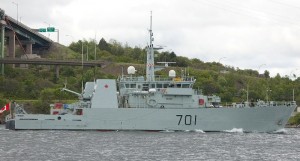In an effort to improve in-service support for Royal Canadian Navy (RCN) ships, submarines and equipment, the Department of National Defence (DND) is moving toward more strategic partnerships with industry to develop and expand Canadian industrial expertise in naval maintenance.
In-service support, or ISS, entails activities such as engineering modification, obsolescence management, maintenance, repair, testing, upgrades, supply or sourcing of spare parts, documentation, and training. Strategic partnerships, as part of ISS, are optimal to prepare for the future naval fleet.
DND has established a Future ISS (FISS) project to formally assist the navy’s transition from its current way of providing ISS to how it will support the fleet of 2018 and beyond. The goal is to define and establish a comprehensive naval materiel FISS system.
 Alanna Jorgensen is a champion of the project. As the Director of Maritime Equipment Program Management, Minor War Vessels and Auxiliaries, Jorgensen is providing senior direction to the management of the FISS project. She will lead the process with the help of a core team to develop and implement the FISS system.
Alanna Jorgensen is a champion of the project. As the Director of Maritime Equipment Program Management, Minor War Vessels and Auxiliaries, Jorgensen is providing senior direction to the management of the FISS project. She will lead the process with the help of a core team to develop and implement the FISS system.
“We are trying to evolve. We want all stakeholders to care about the eventual outcome – having capable and safe ships delivered to the RCN – not just focusing on the current contract,” she says.
In other words, the aim is to have a predictable and collaborative partnership that moves beyond iterative conventional contracts, providing steady workflow, increased efficiencies, and expertise among contractors. A recent example, the long-term submarine contract, highlights the benefits – long-term work for Canadian companies and jobs for Canadians.
“Until recently we have focused on the contract outputs, but now we are moving beyond just doing business with a contractor,” Jorgensen notes. “We are working toward a more stable approach, with industry having a vested interest in the long term and, therefore, exhibiting preventive behaviour. In turn, this strengthens industry’s scope and ability to plan, and boosts local economic benefits.”
The DPS impetus
A key facilitating factor for ISS is that DND and the Canadian Armed Forces are in the midst of improving business processes and maximizing operational capability and readiness.
Central to the Defence Procurement Strategy (DPS), announced in February 2014, is the acquisition of the right equipment and support, at the right time, with the right benefits to industry. More specifically, the DPS’ three key objectives include: delivering the right equipment to the CAF in a timely manner; leveraging purchases of defence equipment to create jobs and economic growth in Canada; and streamlining defence procurement processes.
The strategy responds to the increase in maintenance demands as existing fleets age and new fleets become more technologically advanced. Also, fleet readiness must meet operational demands in an evolving security environment. These trends are expected to continue as fleets are delivered in the coming years, strengthening the case for strategic, long-term industry partnerships in naval ISS.
To expedite those partnerships, the government must study and align various processes; address deficiencies; and leverage the experience of peer organizations. In the case of the RCN, peers include the United Kingdom’s Ministry of Defence and Australia’s Defence Materiel Organisation, which has similarly had to evolve naval ISS in response to government policy and resource constraints.
To date, one of the most valuable lessons learned – and one which Jorgensen underscores – is that materiel ISS functions as a system. Therefore, any changes to the system can have significant knock-on effects. An example sometimes experienced by allied navies is an increased reliance on contractors for ship maintenance, which can diminish crew’s experience and capability, limiting their ability to respond to system failures and maintain operational capability, particularly when deployed. Therefore, a balance has to be struck between the roles and responsibilities of crews and contractors within the ISS system to ensure overall objectives are met.
“There are different roles and relationships within the fleet and one size does not fit all,” says Jorgensen. “Therefore, the ISS system of the future has to be flexible enough to deal with the differences, and we need to take a systematic approach to ensure success.”
FISS will be implemented in four phases: Problem Definition (October 2014); Design (April 2015); System Element Detailed Design (April 2016) and Implementation (commencing in 2016).
For now, Jorgensen says the next steps involve using a holistic approach to identify and define the challenges, assess the available options, develop and design efficiencies, and implement the FISS system.
Or, as she summarizes it, “We’re in the get-smart phase, to be followed by the think-smart and the do-smart phases.”
Elizabeth Smith is a communications contractor with National Defence reporting to the ADM Materiel Group.

